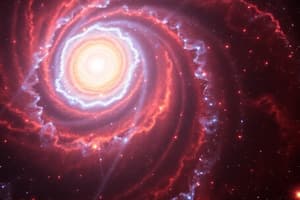Podcast
Questions and Answers
What is the primary role of photosynthesis in the carbon cycle?
What is the primary role of photosynthesis in the carbon cycle?
- Converts carbon dioxide into glucose and oxygen (correct)
- Releases carbon dioxide into the atmosphere
- Increases atmospheric carbon concentration
- Stores carbon in the soil
Which process is responsible for returning carbon to the atmosphere from decomposing organisms?
Which process is responsible for returning carbon to the atmosphere from decomposing organisms?
- Decomposition (correct)
- Respiration
- Combustion
- Photosynthesis
What effect does the enhanced greenhouse effect have on Earth's climate?
What effect does the enhanced greenhouse effect have on Earth's climate?
- Increases the amount of solar radiation reflected into space
- Decreases the average global temperature
- Reduces evaporative cooling from water bodies
- Traps more heat in the atmosphere, leading to global warming (correct)
Which of the following processes reduces carbon dioxide levels in the atmosphere?
Which of the following processes reduces carbon dioxide levels in the atmosphere?
Which greenhouse gas is primarily produced through agricultural practices?
Which greenhouse gas is primarily produced through agricultural practices?
What does the redshift of light from distant galaxies indicate?
What does the redshift of light from distant galaxies indicate?
Which element is NOT predicted from Big Bang nucleosynthesis?
Which element is NOT predicted from Big Bang nucleosynthesis?
What does the Hubble constant (H₀) measure?
What does the Hubble constant (H₀) measure?
Which stage comes immediately after a nebula in a star's life cycle?
Which stage comes immediately after a nebula in a star's life cycle?
What is cosmic microwave background radiation (CMB) primarily considered to be?
What is cosmic microwave background radiation (CMB) primarily considered to be?
What occurs when a high mass star exhausts its hydrogen fuel?
What occurs when a high mass star exhausts its hydrogen fuel?
Which of the following spheres is primarily composed of water?
Which of the following spheres is primarily composed of water?
What happens to low to medium mass stars at the end of their life cycle?
What happens to low to medium mass stars at the end of their life cycle?
Flashcards are hidden until you start studying
Study Notes
Big Bang Theory
- The Big Bang theory proposes that the universe started from a singular point about 13.8 billion years ago.
- It suggests that the universe is expanding since that point, which is supported by observations like redshift and cosmic microwave background radiation (CMB).
- The CMB is leftover heat from the Big Bang, providing evidence for a hot, dense beginning.
Redshift
- Distant galaxies appear shifted towards the red end of the spectrum, meaning they are moving away from us.
- This is a result of the expansion of the universe, stretching the light as galaxies grow further apart.
Hubble Constant
- This constant (H₀) measures the rate at which the universe is expanding.
- It is calculated using the formula v = H₀ × d where v is galaxy velocity ,d is distance and H₀ is the Hubble constant
- The Hubble constant is crucial for understanding the age of the universe and its expansion rate.
Life History of Stars
- A star's life starts as a nebula, a cloud of gas and dust.
- Gravity causes the nebula to condense, forming a protostar that heats up.
- Stars spend most of their time in the main sequence phase, where nuclear fusion occurs.
- When hydrogen fuel runs out, stars grow into a red giant or supergiant.
- Eventually, stars reach the end of their life.
- Low & medium mass stars evolve into white dwarfs and then black dwarfs.
- High mass stars explode in a supernova, forming neutron stars or black holes.
Cosmic Microwave Background Radiation (CMB)
- Faint radiation from the Big Bang that fills the universe.
- Uniformity of CMB supports the Big Bang theory.
Earth's Spheres
- The Earth system is comprised of four main spheres:
- Atmosphere: The layer of gases surrounding the Earth.
- Hydrosphere: All water on Earth, including oceans, lakes, rivers, and groundwater.
- Lithosphere: Earth's solid outer shell, consisting of the crust and upper mantle.
- Biosphere: All living organisms on Earth and their ecosystems
Carbon Cycle
- Carbon movement through Earth's different systems.
- Carbon is released and absorbed through various processes:
- Combustion: Releases carbon dioxide (CO₂) into the atmosphere from burning fossil fuels (coal, oil, gas).
- Respiration: Living organisms release CO₂ as a byproduct of cellular respiration.
- Decomposition: Decomposition of plants and animals releases CO₂ into the air.
- Photosynthesis: Plants consume CO₂ from the atmosphere to produce oxygen and glucose.
- Carbon is stored in diverse locations: the atmosphere, oceans, soils, and living organisms.
Greenhouse Effect
- Natural process where greenhouse gases trap heat in the Earth's atmosphere, keeping the planet warm enough for life.
- Key greenhouse gases include carbon dioxide (CO₂), methane (CH₄), water vapor (H₂O), and nitrous oxide (N₂O).
- Solar radiation reaches Earth's atmosphere.
- Some energy is reflected back into space, while the rest is absorbed by Earth's surface and re-radiated as heat.
- Greenhouse gases trap this heat, stopping it from escaping into space, warming the planet.
- Enhanced Greenhouse Effect: Human activities, such as burning fossil fuels and deforestation, have increased greenhouse gas concentrations, trapping more heat, leading to global warming.
Studying That Suits You
Use AI to generate personalized quizzes and flashcards to suit your learning preferences.




